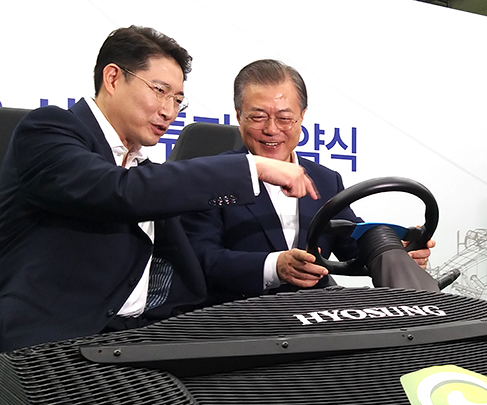Hyosung announces growth plans for carbon fiber business
The company plans to expand its carbon fiber capacity from 2,000 to 24,000 tons of annual output by 2028.

Source | Hyosung
Hyosung (Seoul, South Korea) has announced its plans to increase its annual output of carbon fiber from 2,000 to 24,000 tons by 2028, with a total investment of 1 trillion won (more than $835 million). The company plans to increase its production capacity from one production line to 10 lines.
With the first expansion underway, the company says it will complete a carbon fiber plant with an annual capacity of 2,000 tons in January 2020 and begin full-scale production in February.
Hyosung says that by 2028, the added capacity will bring its market share in carbon fiber up from 2% to 10%, making it the third highest producer of carbon fiber globally. The company also expects to add more than 2,300 new jobs.
The investment announcement was made at an event on Aug. 20 between Hyosung and local government and municipal representatives at its Jeonju, South Korea plant. The company also signed a memorandum of understanding to strengthen cooperation with the Ministry of Trade, Industry and Energy, Iljin Materials and Korea Aerospace Industries.
Hyosung also plans to support the growth of hydrogen-powered vehicles, and says it intends to expand the number of hydrogen-powered cars from around 1,800 in 2018 to about 81,000 by 2022 and 6.2 million by 2040. Carbon fiber is used in the fuel tanks of hydrogen vehicles, and Hyosung says the carbon fiber market for these tanks is expected to grow more than 120 times by 2030.
“We took note of the future value of carbon fiber and started to develop our own technology,” says Hyun-Joon Cho, chairman of Hyosung. “The potential for the upstream industry of carbon fiber is limitless. As the hydrogen economy has opened a new market of carbon fiber, we will play a pivotal role in making Korea a ‘material powerhouse’.”
Related Content
-
The potential for thermoplastic composite nacelles
Collins Aerospace draws on global team, decades of experience to demonstrate large, curved AFP and welded structures for the next generation of aircraft.
-
Co-molding SMC with braided glass fiber demonstrates truck bed potential
Prepreg co-molding compound by IDI Composites International and A&P Technology enables new geometries and levels of strength and resiliency for automotive, mobility.
-
Cutting 100 pounds, certification time for the X-59 nose cone
Swift Engineering used HyperX software to remove 100 pounds from 38-foot graphite/epoxy cored nose cone for X-59 supersonic aircraft.
.jpg;width=70;height=70;mode=crop)





